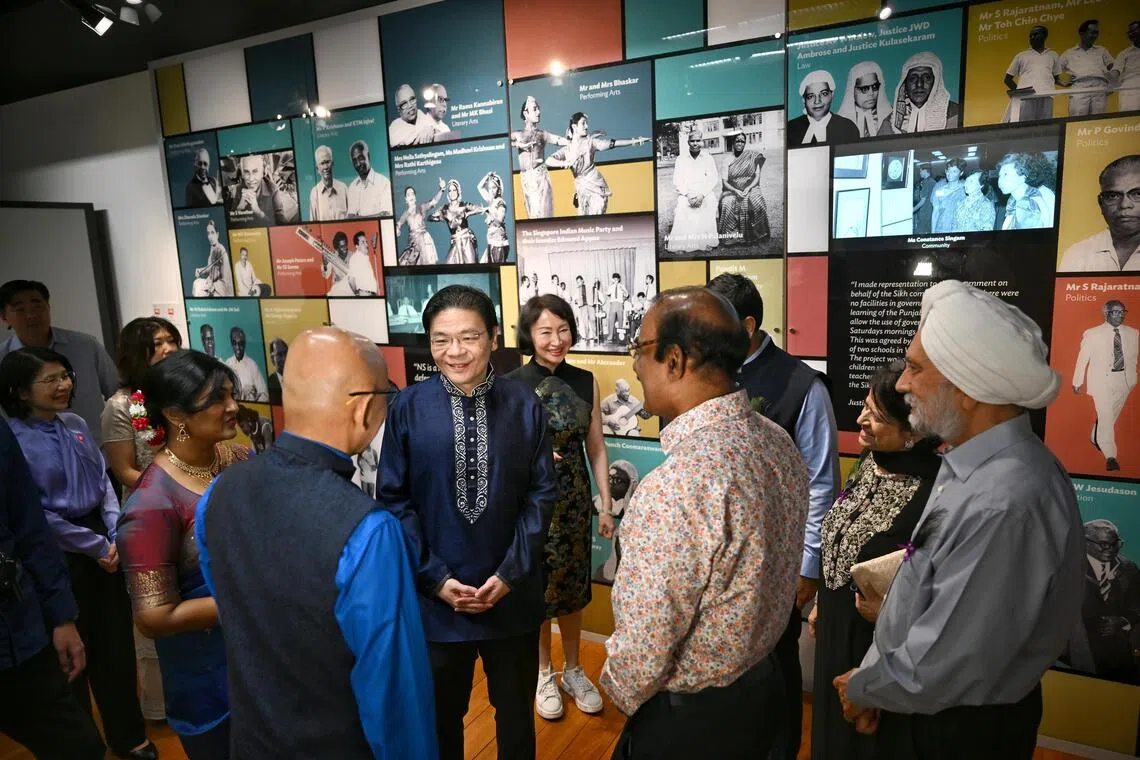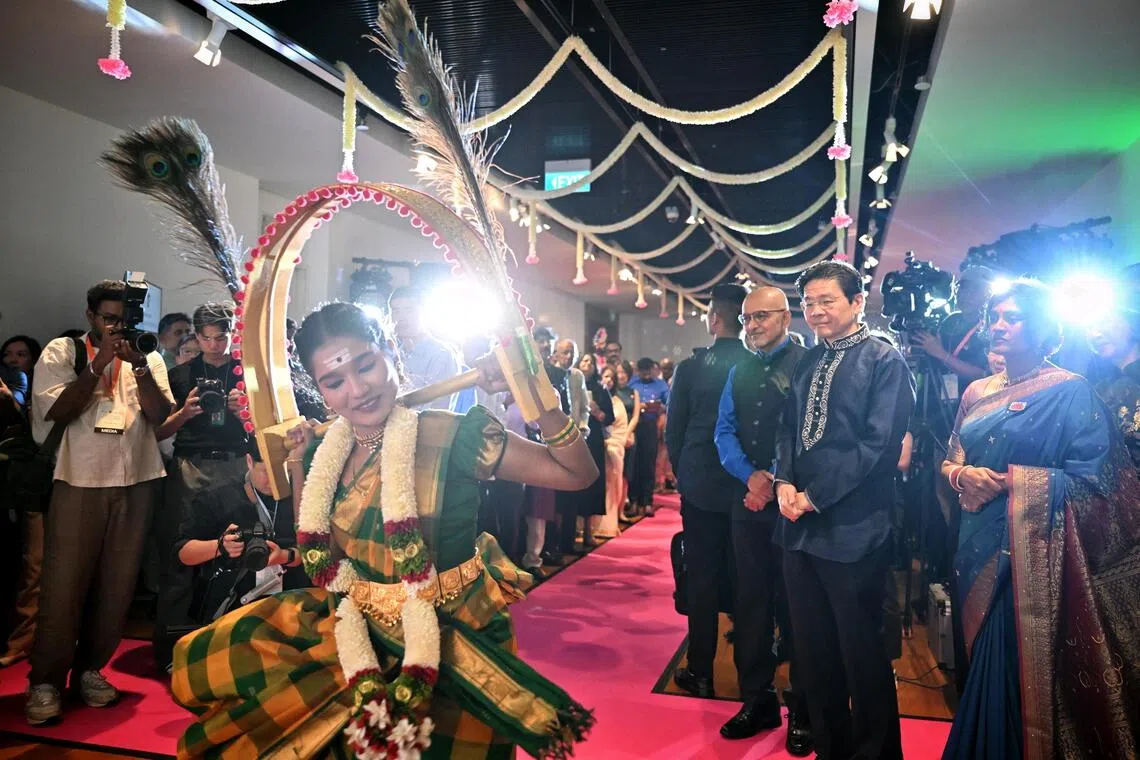Indian community’s contributions show S’pore’s diversity is a source of strength, unity: PM Wong
Sign up now: Get ST's newsletters delivered to your inbox

Prime Minister Lawrence Wong (2nd from left) at the IHC’s 10th Anniversary on Nov 14.
ST PHOTO: ARIFFIN JAMAR
Follow topic:
- PM Wong highlighted the significant contributions of the Indian community to Singapore's rich multicultural tapestry and national identity at the IHC's 10th anniversary.
- IHC is showcasing 60 artefacts in two phases (May and Nov 2025), donated by the community which reflects historical experiences, including WWII and early pioneer contributions.
- IHC plans to engage young people with innovative storytelling and artistic collaborations to deepen heritage appreciation.
AI generated
SINGAPORE - Since the earliest days of modern Singapore, people from the Indian sub-continent have come to the island, bringing with them their skills, beliefs and hopes for a better life.
These early Indian immigrants came from different regions, including Tamil Nadu, Kerala, Bengal, Punjab, Gujarat and Maharashtra. They spoke different languages, practised different faiths and carried with them the rich diversity of Indian civilisation.
“They enriched our society with a vibrant array of customs, cuisines, arts and festivals… from Deepavali and Pongal to Thaipusam,” said Prime Minister Lawrence Wong at a dinner on Nov 14 to mark the 10th anniversary of the Indian Heritage Centre (IHC), which is located in Little India.
As a result, Indian influences are deeply woven into the Republic, from the flavours that Singaporeans enjoy to the words spoken here, he added.
Like the Indian community, the city-state is a tapestry woven from many threads – multiracial, multi-religious and multicultural, he said.
“Our diversity need not and must not divide us. Instead, when we respect one another, when we celebrate one another’s culture, our diversity becomes a tremendous source of strength and unity,” he said.
PM Wong noted that the efforts of successive generations of immigrants from India have helped the Singapore Indian community to flourish, keeping alive its rich heritage while embracing a shared and distinctive sense of national identity.
“So you are not just Indians in Singapore; you are Singaporean Indians,” he said.
“We are Singaporeans first. We are rooted in our respective cultures, respective roots, yet deeply woven into the fabric of our nation. And you, all of you, our Indian community, are a proud and vital part of our Singapore story.”
The IHC was set up to tell this story, and in just 10 years it has done this admirably, he said.
He noted that the IHC – which was established in 2015 in conjunction with Singapore’s 50th anniversary celebrations – has curated rich and engaging exhibitions that showcased the diversity of the community, and its many contributions to Singapore’s development and success.
Pioneers of the community include entrepreneur and philanthropist P. Govindasamy Pillai; the followers of Sree Narayana Guru, who set up a mission to serve the less privileged; and Singapore’s first foreign minister S. Rajaratnam, who penned the National Pledge, which envisioned Singapore as “one united people, regardless of race, language, or religion”, PM Wong said.
Importantly, the IHC has reached out to Singaporeans of all backgrounds and has welcomed almost 1.8 million visitors through its doors. The centre has collaborated with the Singapore Chinese Cultural Centre and the Malay Heritage Centre to highlight the common ground among different communities, he added.
To mark its anniversary and Singapore’s diamond jubilee, IHC has embarked on its first major artefact rotation at its permanent galleries, with 60 artefacts being showcased in two phases.
The first phase
These artefacts highlight the efforts of the pioneers who laid the foundation of trades, associations and schools in the pre-war period, their involvement in the Indian independence movement, lives and experiences of civilians during World War II, and prominent figures who contributed to Singapore’s nation-building years.
Most of them were donated by or are on loan from members and organisations of the Singapore Indian and South Asian communities.
One of the donors is Dr N. Varaprasad, who contributed a collection of memorabilia and photographs relating to his family’s migration history and his father’s World War II experiences.
Among them is a photograph from the 1940s showing his father, Mr S. Natarajan, as a soldier with the Indian National Army in Burma (now Myanmar).
The picture illustrates how members of Singapore’s Indian and South Asian communities contributed to the Indian independence movements during that period, and is an important snapshot of Singapore’s wartime past.
Mr Natarajan was a founding member of the Singapore Indian Fine Arts Society, president of the Singapore Indian Association and the first chairman of the Hindu Endowments Board.

Prime Minister Lawrence Wong (2nd from right) at The Indian Heritage Centre's 10th Anniversary on Nov 14.
ST PHOTO: ARIFFIN JAMAR
Dr Varaprasad, who was the former chief executive of the National Library Board, also contributed to the IHC a copper water boiler his mother carried on her journey from South India to Burma, and later to Singapore in the early 1900s.
The 77-year-old said: “As a record, it’s important to let people know how past generations went through a lot of trials and tribulations… We owe a great deal to our forefathers and I think people ought to know that.”
Another donor, Ms Rowena Row, 64, a member of Singapore’s Chetti Melaka (Peranakan Indian) community, contributed items that belonged to her late mother Nellachi Pillay, including a set of teaching tools that her mother had used as an educator for the visually impaired.
“It’s a snapshot in time, a nice story to tell,” she said. “If we don’t donate the artefacts, their significance may be gone.”
Mr Asad Shiraz, 68, a member of Singapore’s Dawoodi Bohra Muslim community, donated Japanese Occupation-era documents issued to his late father, Mr Shiraz Mohamedali, such as a registration card and medical auxiliary service booklet which indicated his role as a stretcher bearer at the 33rd civil (air) defence station.
“Rather than it being lost or given to the karang guni man, I would rather donate the items to people who look after them with love and care,” he said.
Beyond artefacts, IHC received cash donations amounting to $320,000 from community stakeholders, business owners in Little India as well as individuals. IHC plans to use the donations to foster greater appreciation and understanding of Indian and South Asian heritage.
PM Wong said that as the centre enters its second decade, it should continue to find new and creative ways to tell the story of the Indian community here, and in doing so, to illuminate the broader Singapore story – one of diversity, unity and shared destiny.
IHC chairman R. Rajaram said seven in 10 of the Singapore visitors to the centre in 2024 were non-Indian. For the next decade, IHC will think boldly about how heritage can continue to matter in a fast-changing world, so that visitors do not just see history, but feel that they are a part of it.
“We will deepen our engagement, particularly with young people, and invite them to reimagine their heritage through new forms of storytelling and artistic collaborations,” he said. “To do this meaningfully, we must and will invest in ideas, partnerships and people.”


